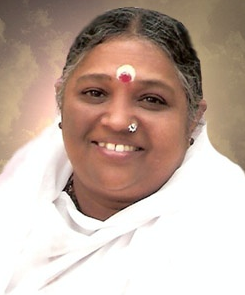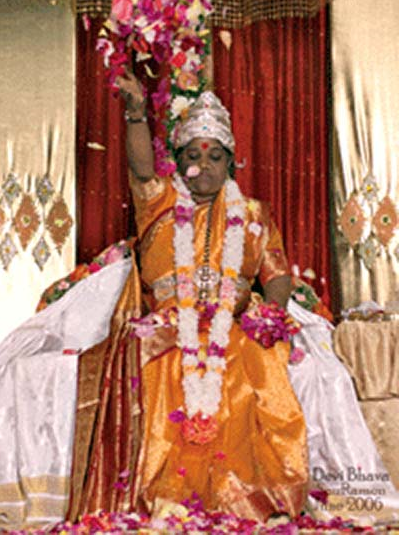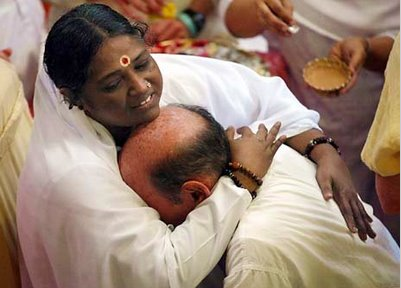AMMACHI TIMELINE
1953 (September 27) Ammachi was born Sudhamani Idamannel in Kerala, India.
1975 Ammachi experienced an identification with Sri Krishna ( Krishnabhava) and with Devi (Devi bhava).
1981 An ashram, Amritapuri, was established in India.
1987 Ammachi visited the U.S. and became very popular with Western religious seekers.
1989 An ashram was established in San Ramon, California.
1993 Ammachi delivered a speech at the World Parliament of Religions in Chicago.
2002 Ammachi received the Gandhi-King Award for Non-Violence.
FOUNDER/GROUP HISTORY
Sri Mata Amritanandamayi Devi, also known as Amma or Ammachi, was born Sudhamani (“Pure Jewel”) Idamannel on September 27, 1953, as the fourth child to a poor fishing family in Kerala, India. Sudhamani suspended her formal education during the fourth grade at the age of nine to raise her younger siblings and assist with domestic tasks in her family’s household after her mother became ill. She never married. Beyond these few basic facts, information on Sudhamani’s early life is almost exclusively drawn from hagiographic accounts, with Amritaswarupanada (1994) being the primary source.
In the hagiographic accounts, Sudhamani is depicted as spiritual from birth, having chosen a self-sacrificial way of life, and
 possessing extraordinary powers. According to these accounts, the signs of Sudhamani’s future spirituality began prior to her birth. During pregnancy her mother “began having strange visions. Sometimes she had wonderful dreams of Lord Krishna. At others she beheld the divine play of Lord Shiva and Devi, the Divine Mother” (Amritaswarupanada 1994:13). When Sudhamani was born she had a dark blue complexion and would lay in the lotus position of hatha yoga (chinmudra). By the time that she was six months old “she began speaking in her native tongue, and at the age of two began singing devotional songs to Sri Krishna…[E]even at an early age Sudhamani exhibited certain mystical and suprahuman traits, including compassion for the destitute. In her late teens, she developed an intense devotion to and longing for Krishna…sometimes she danced in spiritual ecstasy, and at other times she wept bitterly at the separation from her beloved Krishna” (Raj 2004:206). Sudhanami reportedly was so absorbed with Lord Krishna that “If she suddenly realized she had taken several steps without remembering Krishna, she would run back and walk those steps again, repeating the Lord’s name” (Johnsen 1994:95).
possessing extraordinary powers. According to these accounts, the signs of Sudhamani’s future spirituality began prior to her birth. During pregnancy her mother “began having strange visions. Sometimes she had wonderful dreams of Lord Krishna. At others she beheld the divine play of Lord Shiva and Devi, the Divine Mother” (Amritaswarupanada 1994:13). When Sudhamani was born she had a dark blue complexion and would lay in the lotus position of hatha yoga (chinmudra). By the time that she was six months old “she began speaking in her native tongue, and at the age of two began singing devotional songs to Sri Krishna…[E]even at an early age Sudhamani exhibited certain mystical and suprahuman traits, including compassion for the destitute. In her late teens, she developed an intense devotion to and longing for Krishna…sometimes she danced in spiritual ecstasy, and at other times she wept bitterly at the separation from her beloved Krishna” (Raj 2004:206). Sudhanami reportedly was so absorbed with Lord Krishna that “If she suddenly realized she had taken several steps without remembering Krishna, she would run back and walk those steps again, repeating the Lord’s name” (Johnsen 1994:95).
Sudhamani’s childhood is described as very difficult. According to Johnsen (1994:95) she was “the victim of years of physical and psychological abuse.” Her duties in taking care of her mother reduced her to a virtual “house slave” who was “beaten and treated as a servant” (Associated Press 2009). Sudhamani demonstrated great compassion for the suffering and poverty that she encountered in her hometown, and she began comforting and hugging the impoverished and ill, even those deemed untouchable by society. As a result, she was regarded by her family as mentally ill, and her brother is said to have attacked her with a knife for the embarrassment she was causing the family. Sudhamani’s parents attempted to arrange a marriage for her, but Sudhamani had decided not to marry and vigorously rejected their initiative (Raj 2004:206). As a result of these various difficulties, Sudhamani ran away from home on occasion and even considered drowning herself.
The transformational moments during which Sudhamani moved toward her spiritual identity as Ammachi began in September, 1975. As she was returning home after tending cattle, she reported having had a “spiritual rapture” and became aware of her identification and oneness with Krishna (Raj 2004:206). For the next two years Ammachi was said to be in the mood of Krishna ( Krishnabhava). Just six months after her initial rapture she had a second rapture in which she experienced oneness with Devi, the divine mother (Devi bhava). It is this latter identity as the Divine Mother that she has continued to express. By the late 1970s Ammachi was gathering a coterie of disciples. In 1978, a young man named Balu became one of Ammachi’s first disciples, followed in 1979 by two Westerners, an American, now Swami Amritswarupananda, and an Australian, now Armritswarupananda. The movement created its first formal ashram, Amritapuri, in 1981. Ammachi first visited the U.S. in 1987; she was enthusiastically received and gathered a devoted following of religious seekers who consider her a personal guru. Every year Ammachi makes an annual tour to nations around the world. There are now santangs in over thirty countries.
DOCTRINES/BELIEFS
Ammachi’s followers consider her both a manifestation of the Divine Mother goddess and a guru. According to Kremer (2009:5), “Devotees look to Ammachi, not to scriptures, ideas, philosophy, or traditional theology. Ammachi is their foundation, their ideal to strive for, their lens to view other religious ideas and texts through, and their example for moral action. Ammachi is the ultimate authority, and as a living symbol and mother goddess incarnated, she is the base for divine knowledge.” Despite her lack of formal training, Ammachi is believed by her followers to be a true spiritual master (satguru).
Ammachi’s primary teaching to her followers is to seek liberation by serving God and surrendering ego and desire. It is devotion to God that leads to a loss of ego. Devotees seek this goal through meditation, recitation, and community service. As an incarnation of the Divine on earth ( avatar), Ammachi is believed to have completely eliminated her ego, a separate sense of selfhood (Edelstein 2000). As Ammachi has put it: “Reasoning is necessary, but we should not let it swallow the faith in us. We should not allow the intellect to eat up our heart. Too much knowledge means nothing but a big ego. The ego is a burden, and a big ego is a big burden” (Johnsen 1994:99). She teaches that “The love of awakened motherhood is a love and compassion felt not only towards one’s own children, but towards all people … to all of nature,” she says. “This motherhood is Divine Love – and that is God” (Lampman 2006). The ideal of “universal awakened motherhood” is one of Ammachi’s central tenets. She exalts motherhood, love and compassion, and exhorts her followers to be true mothers, regardless of their gender, by exhibiting these maternal qualities to all of creation.
Gender equality plays a major role in Ammachi’s doctrines. She seeks to empower women through her spiritual practices and teachings. In her scripture Awaken, Children!, Ammachi proclaims that “spiritual realization is easier for a woman to attain than for a man, provided she has the proper discrimination and determination” and that “women are the repositories of infinite power. In spiritual matters they can surpass what many men attempt to do; therefore, do not think that women are lower than men” (Kremer 2009:10). Ammachi “teaches men to see their wives as the Divine Mother and women to see their husbands as the Lord of the World, and also to serve their families, the community, and the world. Humility and service are her constant themes” (Johnsen 1994:101).
RITUALS/PRACTICES
Ammachi’s central ritual is the Devi bhava darshan, which allows a devotee to experience a mystical connection with a deity by seeing and being seen by the deity. Ammachi’s darshan features hugging, which is atypical since physical contact is generally eschewed by Hindu gurus. This has led to Ammachi’s sobriquet, “the hugging saint.” Ammachi reportedly developed and then ritualized this practice in the course of soothing those who came to her for advice and consolation.
Ammachi’s Devi bhava is elaborate and highly ritualized. She is seated on a floor mat, often decorated with flowers, and attended by a female disciple who performs the ritual foot worship (pada puja) by sprinkling water on Ammachi’s feet, then placing sandal paste and flowers on them. Two monks recite from the Sanskritic slokas, followed by the ceremonial waving of a lamp. Another devotee decorates Ammachi with a garland. There is a lecture on Ammachi’s message and spirituality. Finally, Ammachi and an Indian band lead the devotional singing (bhajan). After a period of meditation, Ammachi’s devotees are invited to approach her individually for her trademark embrace.
by a female disciple who performs the ritual foot worship (pada puja) by sprinkling water on Ammachi’s feet, then placing sandal paste and flowers on them. Two monks recite from the Sanskritic slokas, followed by the ceremonial waving of a lamp. Another devotee decorates Ammachi with a garland. There is a lecture on Ammachi’s message and spirituality. Finally, Ammachi and an Indian band lead the devotional singing (bhajan). After a period of meditation, Ammachi’s devotees are invited to approach her individually for her trademark embrace.
Each devotee receives a hug from Ammachi, as well as words of comfort (Ammachi speaks her native language, Malayalam, and has limited fluency in English). She then presents each follower with a small token piece of chocolate, rose petals and sacred ash. Each hug is treated as “a hug from the mother goddess herself” as Ammachi is understood to be “a vessel for the goddess to communicate through her” and “a passive recipient of a transcendent deity” (Kremer 2009:3). Ammachi has reportedly administered over thirty million hugs in sessions that can last up to twenty hours. Vasudha Narayanan, director of the Center for the Study of Hindu Traditions at the University of Florida, described Ammachi’s hugs as “a sermon,” and the “experience so moves some that they give up their lives to follow the guru” (Associated Press 2009). Johnsen points out that “Many teachers emphasize the importance of love, but Ammachi’s words have particularly potent impact on so many who have met her because they see that she walks her talk” (Johnsen 1994:100). Ammachi herself has described the hugs as having great spiritual significance: “Amma’s hugs and kisses should not be considered ordinary. When  Amma embraces or kisses someone, it is a process of purification and inner healing. Amma is transmitting a part of Her pure vital energy into Her children. It also allows them to experience unconditional love. When Amma holds someone it can help to awaken the dormant spiritual energy within them, which will eventually take them to the ultimate goal of Self-realization” (Raj 2005:136-7). One of Ammachi’s devotees communicates the power of this encounter as follows: “Ammachi gives all the time, twenty four hours a day…She lavishes her love freely on everyone who comes to her. She may be firm with them, but she always radiates unconditional love. That’s why people are so shaken after they meet her. She’s a living example of what she teaches, of what all the scriptures teach” (Johnsen 1994:100).
Amma embraces or kisses someone, it is a process of purification and inner healing. Amma is transmitting a part of Her pure vital energy into Her children. It also allows them to experience unconditional love. When Amma holds someone it can help to awaken the dormant spiritual energy within them, which will eventually take them to the ultimate goal of Self-realization” (Raj 2005:136-7). One of Ammachi’s devotees communicates the power of this encounter as follows: “Ammachi gives all the time, twenty four hours a day…She lavishes her love freely on everyone who comes to her. She may be firm with them, but she always radiates unconditional love. That’s why people are so shaken after they meet her. She’s a living example of what she teaches, of what all the scriptures teach” (Johnsen 1994:100).
During the early years Ammachi would give hugs to as many as one thousand visitors each day, with double that number receiving hugs on Devi Bhava nights. In India the hugs sometime lasted for ten minutes. As the ritual has become institutionalized and the size of audiences has increased dramatically, each individual has received less personal time with Ammachi, now only a few seconds to a few minutes. Devotees receive a personal initiation and mantra from Ammachi. Consistent with “one Truth” message, Ammachi’s devotees are allowed to select a Hindu, Devi, Christian, Buddhist mantra, or even one in which the deity is not specified.
ORGANIZATION/LEADERSHIP
Amachi has never been initiated as a guru but is treated as a perfect spiritual master (sat guru) by her devotees, one who is capable of achieving god realization. Her devotees credit her with extraordinary powers. Reportedly she eats very little and often sleeps only a few hours a night. Her spokesman, Rob Sidon, remarks that ”We can’t keep up with her. I have to go to bed. She keeps going. You wake up and she’s still at it. After 15 hours she’s radiant” (Reuters 2001). Her powers are said to include levitation, clairvoyance, being in two locations simultaneously (bilocation), healing of both physical and emotional disorders; creating children for childless couples and absorbing or inhaling devotees’ negative karma” (Raj 2004:207). Some of Ammachi’s most famous miracles include turning water to milk, healing a leper, and permitting “a poisonous cobra to flick its tongue against her own” (Associated Press 2009). Ammachi’s first Western disciple, Neal Rosner, related the story of Ammachi healing a leper by “lick[ing] the pus out of his sores’” until the leprosy disappeared except for one sore (Johnsen 1994:106). Ammachi herself refers to such power: “If you were to really see Amma as She is, it would overwhelm you – you couldn’t possible bear it. Because of this, Amma always covers herself with a thick layer of Maya (illusion)” (Raj 2005:127). In addition to spiritual leadership, Ammachi oversees the movement’s extensive charitable activities.
In the late 1970s Ammachi and her small group of devotees established her first ashram, a simple thatched hut near her home.  Two years later Amritapuri, her first formal ashram, was constructed. The ashram has continued to grow and now includes a temple a large dormitory. There are several hundred permanent residents and several hundred more visitors along with a small coterie of initiated, renunciate sannyasis and sannyasinis. The permanent residents at Ammachi’s ashrams, brahmacharins, follow a strict program of discipline (tapas), which “stipulates eight hours of meditation daily in addition to constant social service activities.
Two years later Amritapuri, her first formal ashram, was constructed. The ashram has continued to grow and now includes a temple a large dormitory. There are several hundred permanent residents and several hundred more visitors along with a small coterie of initiated, renunciate sannyasis and sannyasinis. The permanent residents at Ammachi’s ashrams, brahmacharins, follow a strict program of discipline (tapas), which “stipulates eight hours of meditation daily in addition to constant social service activities.
Ammachi first visited the U.S. in 1987, and an ashram that became her headquarters in the U.S. was established in San Ramon, California in 1989 on land donated by a devotee. This ashram houses a group of celibate devotees who practice meditation, recitation, and community service. Local chapters have been established in a number of large cities around the U.S. that are administered primarily by volunteers. American devotees are predominantly Caucasian and female, and women occupy the majority of local leadership  positions. According to Raj (2005:130), “Western disciples seem more attracted to the asceticism of Ammachi’s spirituality….Indians seem more drawn to the devotional tradition Ammachi embodies.” The highest levels of movement leadership continue to be held by male renunciant devotees. Converts from Siddha Yoga and Transcendental Meditation are commonplace (Raj 2004:210).
positions. According to Raj (2005:130), “Western disciples seem more attracted to the asceticism of Ammachi’s spirituality….Indians seem more drawn to the devotional tradition Ammachi embodies.” The highest levels of movement leadership continue to be held by male renunciant devotees. Converts from Siddha Yoga and Transcendental Meditation are commonplace (Raj 2004:210).
Ammachi also operates a number of charitable organizations, including “four hospitals, 33 schools, 12 temples, 25,000 houses for the poor, an orphanage, pensions for 50,000 destitute women, a home for senior citizens, a battered women’s shelter and various technical education projects” (Reuters 2001). The Mata Amritanandamayi (M.A.) Center in the U.S. donated one million dollars to the Bush-Clinton Katrina Fund. And Ammachi committed $23 million for rebuilding after the South Asian tsunami (Lampman 2006). Visitors are not charged for darshan or for receiving mantras; instead the movement supports its charitable activity through donations and sale of a variety of souvenir items.
ISSUES/CHALLENGES
Ammachi has generated only a modest amount of controversy (Falk 2009). Predictably, there have been Christian critiques of her teachings (Jones 2009). Other critics have taken issue with her directives to separate couples as part of their spiritual practice (sadhana) in order to “put pressure on their egos,” to maintain celibacy, and to engage in long periods of meditation with limited hours of sleep (Edelstein 2000). They dismiss Ammachi’s following as a personality cult and “they question the finances of her organization or even claim it is linked to radical groups” (Associated Press 2009). The legitimacy of Ammachi’s miracles also has been challenged, particularly in India where the tensions between traditionalist Hindus and secular rationalists remain high (Pattahanam 1985). Her followers claim that opponents have made several attempts on her life (Kremer 2009:7).
Some members of the traditional Hindu community resist Ammachi’s egalitarian teachings and practices as they violate traditional Hindu purity/pollution and gender norms. She allows menstruating women, who are considered impure, to participate in her darshan. She has elevated the status of women by allowing them to be priests within her movement. Ammachi also rarely holds gatherings in Hindu temples, preferring secular venues that are accessible to and comfortable for Western devotees. At the same time she requires modest dress for women and uses women as models of selfless service. It is the combination of her empowerment of women together with her commitment to the Hindu tradition and a divine mother model for women that is the source of her enormous appeal to women caught between traditional and modern worlds.
These various criticisms of Ammachi have been far outweighed by the adulation she continues to receive from disciples, the honors that she has received, the support of influentials around the world, and the popularity she enjoys on her annual world tours. She was invited to speak at the World Parliament of Religions in Chicago in 1993. She was invited to speak at the UN’s 50th anniversary in 1995 and at the Millennium World Peace Summit in 2000. In 2002, Ammachi won the Gandhi-King Award for her promotion of nonviolence. In the same year she delivered the keynote address at The Global Peace Initiative of Women Religious and Spiritual Leaders. In 2006, Ammachi received an interfaith award that previously had been given to only the Dalai Lama and Bishop Desmond Tutu. She has been compared to Mother Teresa and heralded a mystic and a saint, and she is now “one of the most recognizable and popular Hindu female gurus in India” (Kremer 2009:8).
REFERENCES
Amritaswarupananda, Swami. 1994. Ammachi: A Biography of Mata Amritanandamayi. San Ramon, CA: Mata Amritanandamayi Center.
Associated Press, 2009. “Millions Flock to India’s Hugging Guru.” AP. 8 March 2009. Accessed from http://thestar.com.my/news/story.asp?file=/2009/3/8/apworld/20090308082927&sec=apworld on February 5, 2012.
Edelstein, Amy. 2000. “Ammachi the ‘Mother of Immortal Bliss’.” EnlightenNext Magazine (Spring-Summer). Accessed at http://www.throughyourbody.com/fantastic-interview-with-mata-amritanandamayi-the-mother-of-immortal-bliss/ on 13 February 2012.
Falk, Geoffrey. 2009. Stripping the Gurus. Toronto: Million Monkeys Press.
Johnsen, Linda. 1994. “Ammachi: In the Lap of the Mother.” In Daughters of the Goddess: The Women Saints of India., 95-110. St. Paul, MN: Yes International Publishers.
Jones, Jovan. 2009. Chasing the Avatar. Shippensburg, PA: Destiny Image.
Kremer, Michael. 2009. Is The Guru a Feminist? Charismatic Female Leaders and Gender Roles in India. M.A. Thesis. Columbia: University of Missouri.
Lampman, Jane. 2006. “Hugging Saint is Compassion in Action.” Christian Science Monitor, July 27. Accessed from http://www.csmonitor.com/2006/0727/p14s01-lire.html on 10 February 2012.
Pattahanam, Sreeni. 1985. Matha Amritanandamayi: Sacred Stories and Realities . Kollam, Kerala, India: Mass Publicationas.
Raj, Selva J. 2005. “Passage to America: Ammachi on American Soil.” In Gurus in America, edited by Thomas Forsthoefel and Cynthia Ann Humes, 123-46. Albany: State University of New York Press.
Raj, Selva J. 2004. “Ammachi, the Mother of Compassion.” In The Graceful Guru: Hindu Female Gurus in India and the United States, edited by Karen Pechilis, 203-17. New York: Oxford University Press.
Tippit, Sarah. 2001. “Indian Guru Seeks to Love the World Personally.” Reuters. 27 June 2001. Accessed from http://wwrn.org/articles/13398/?&place=united-states§ion=hinduism on 5 February 2012.
Authors:
David G. Bromley
Stephanie Edelman
Post Date:
15 March 2012
